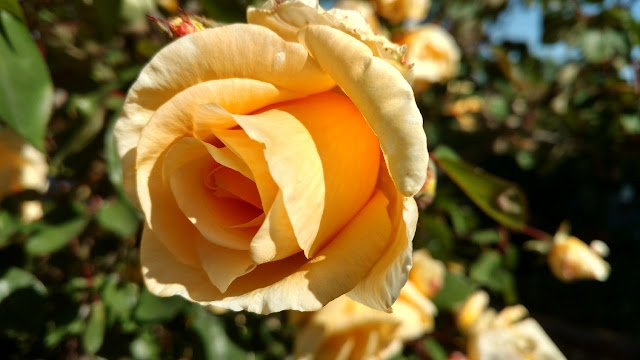
Invest some time in free master gardener workshops

|
|
Lady Hillingdon is a tea rose introduced in 1910. Learn all about roses from the Placer County master gardeners this weekend. (Photo: Debbie Arrington)
|
The fall calendar fills up quickly, with so many potential events. At least with Zoom workshops, gardeners can get expert information without having to worry about traffic and parking.
Here are two excellent free online workshops by UCCE master gardeners this Saturday:
-- Successful Gardening with Native Plants, 9 a.m. to 10:30 a.m. Saturday on Zoom. The El Dorado County master gardeners present this class taught by Alice Cantelow.
Here's the description: "Do you love wildlife, pollinators, and birds, and would like to enjoy their activities in your landscape? Are you ready to lower your water bill, and spend less on fertilizers and pesticides as well? Alice Cantelow will teach you how to choose and add colorful, easy care native plants to your garden."
Register here , and a Zoom link will be sent to you.
The El Dorado master gardeners have a busy calendar of fall events, including information meetings on master gardener training for El Dorado and Amador county residents: http://mgeldorado.ucanr.edu/?calendar=yes&g=39875
-- Roses Zoom Workshop, 10:30 a.m to 11:30 a.m. Saturday. This event is presented by the Placer County master gardeners.
Here's what they say: "Hardy beautiful roses grow well in many places throughout the country. In this workshop you will learn about some of the origins of roses in America. You’ll become acquainted with the categories of roses for your landscape and learn that roses don’t have to be labor-intensive plants. You’ll learn to recognize some common pests and diseases associated with roses, and how you can safely manage them during different seasons of the year."
No pre-registration is necessary. The link for this workshop is here: https://us02web.zoom.us/j/87189294280? and the passcode is: garden.
The full list of Placer County master gardener fall events can be found here: http://pcmg.ucanr.org/
-- Kathy Morrison
Comments
0 comments have been posted.Sacramento Digs Gardening to your inbox.
Food in My Back Yard Series
May 6: Maintain soil moisture with mulch for garden success
April 29: What's (already) wrong with my tomato plants?
April 22: Should you stock up on fertilizer? (Yes!)
April 15: Grow culinary herbs in containers
April 8: When to plant summer vegetables
April 1: Don't be fooled by these garden myths
March 25: Fertilizer tips: How to 'feed' your vegetables for healthy growth
March 18: Time to give vegetable seedlings some more space
March 11: Ways to win the fight against weeds
March 4: Potatoes from the garden
Feb. 25: Plant a fruit tree now -- for later
Feb. 18: How to squeeze more food into less space
Feb. 11: When to plant? Consider staggering your transplants
Feb. 4: Starting in seed starting
Sites We Like
Garden Checklist for week of May 11
Make the most of the lower temperatures early in the week. We’ll be back in the 80s by Thursday.
* Plant, plant, plant! It’s prime planting season in the Sacramento area. Time to set out those tomato transplants along with peppers and eggplants. Pinch off any flowers on new transplants to make them concentrate on establishing roots instead of setting premature fruit.
* Direct-seed melons, cucumbers, summer squash, corn, radishes, pumpkins and annual herbs such as basil.
* Harvest cabbage, lettuce, peas and green onions.
* In the flower garden, direct-seed sunflowers, cosmos, salvia, zinnias, marigolds, celosia and asters. (You also can transplant seedlings for many of the same flowers.)
* Plant dahlia tubers.
* Transplant petunias, marigolds and perennial flowers such as astilbe, columbine, coneflowers, coreopsis, dahlias, rudbeckia and verbena.
* Keep an eye out for slugs, snails, earwigs and aphids that want to dine on tender new growth.
* Feed summer bloomers with a balanced fertilizer.
* For continued bloom, cut off spent flowers on roses as well as other flowering plants.
* Add mulch to the garden to maintain moisture. Mulch also cuts down on weeds. But don’t let it mound around the stems or trunks of trees or shrubs. Leave about a 6-inch-to-1-foot circle to avoid crown rot or other problems.
* Remember to weed! Pull those nasties before they set seed.
* Water early in the day and keep seedlings evenly moist.